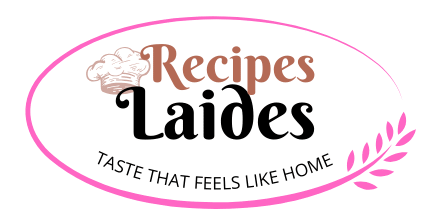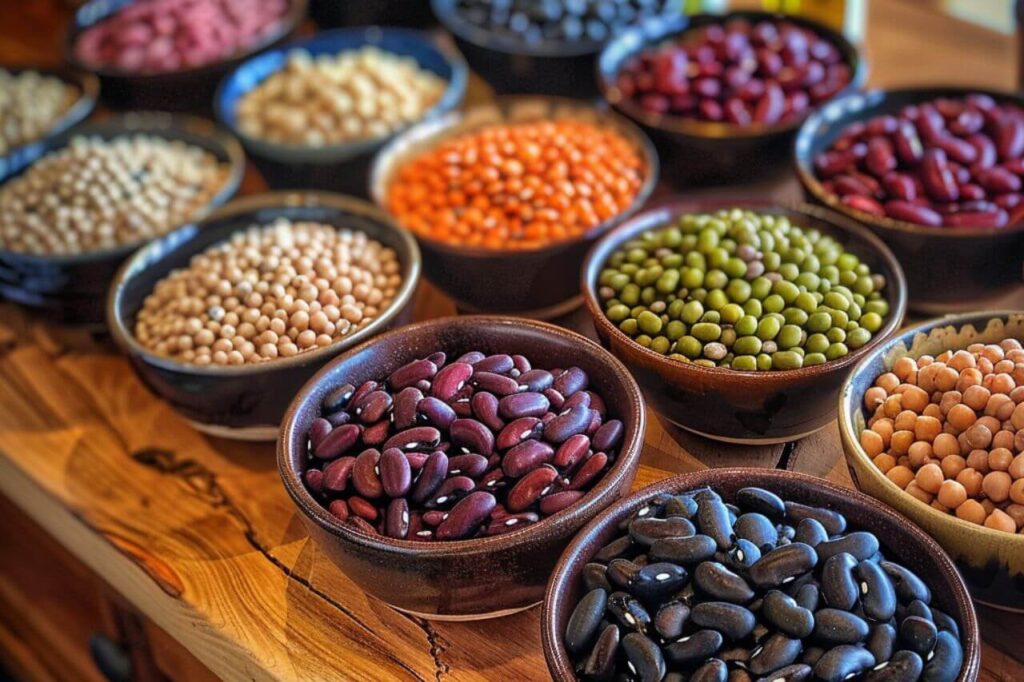Growing up, I loved the smell of beans cooking. It sparked my interest in beans. Each type has its own story of nutrition, culture, and flavour.
Beans are a staple in many cuisines around the world—affordable, protein-rich, and incredibly versatile. From soups and stews to salads and plant-based dishes, understanding the different types of beans can help you choose the best one for your cooking needs.
In our full guide, What Are the 15 Types of Beans?, we break down the most popular varieties, including black beans, kidney beans, chickpeas, and more. If you’re looking for creative ways to use legumes, try our hearty Pickle Pasta Salad or protein-packed Pistachio Dessert Recipes.
This list of bean types is great for anyone following a vegetarian, vegan, or high-fibre diet.
This guide will explore the world of beans. We’ll look at their origins, health benefits, and how they can make your food better. Get ready to see how beans can change your cooking and health.
Key Takeaways
- Beans offer incredible nutritional diversity
- Each bean variety has a unique flavour profile
- Beans are essential in global cuisines
- Nutrition and taste vary across different types of beans
- Cooking methods significantly impact bean texture and flavour
Understanding the World of Beans and Legumes
Beans are a fascinating food group that plays a big role in nutrition and cooking. Many people think beans and legumes are the same, but they’re not. This journey into legumes vs beans will show you how these foods can change your diet.
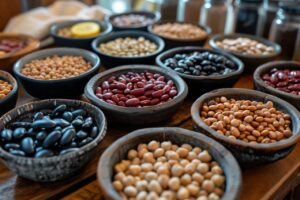
Legumes are a wide family that includes beans, peas, lentils, and peanuts. Beans are a part of this family, known for their seed pods and great nutrition. When looking for the healthiest beans, you’ll find many options full of important nutrients.
Best Beans for Soups & Stews
Kidney Beans – Rich, hearty texture (chili staple)
Navy Beans – Creamy consistency for baked beans
Great Northern Beans – Mild, great in vegetable soups
Nutritional Powerhouse
The healthiest beans to eat are a nutritional powerhouse. They offer:
- Complete plant-based protein
- Complex carbohydrates
- Essential minerals like iron and magnesium
- Antioxidants that support overall health
“Beans are nature’s multivitamin, delivering nutrition in a delicious package.” – Nutritional Expert
Basic Bean Classifications
Beans can be grouped into several types based on their features:
- Bush Beans: Compact plants with shorter growth cycles
- Pole Beans: Climbing varieties requiring support
- Dry Beans: Harvested when fully mature and dried
- Fresh Beans: Picked and consumed while still green
Exploring the world of legumes vs beans opens up new possibilities in cooking and nutrition. Adding these versatile, nutrient-rich foods to your diet can greatly benefit your health.
Most Popular Types of Beans for Cooking
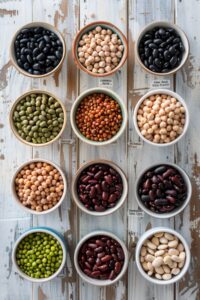
Exploring the world of beans can make you a better cook. It opens up new flavours, textures, and health benefits. A list of beans for cooking gives you a wide range to choose from.
Kidney beans are a favorite in many kitchens. They have a deep red colour and a strong taste. They’re great in chilli, salads, and stews. Their meaty texture is perfect for adding bulk to vegetarian dishes.
- Black beans: Known for their rich, earthy flavor, they’re a hit in Latin American dishes and bean salads
- Navy beans: Smooth and creamy, ideal for soups and baked beans
- Pinto beans: Essential in Mexican cooking, with a soft texture and nutty taste
Choosing the right beans can change your dish. Some are better in cold salads, while others are perfect for slow-cooked meals. Trying different beans can lead to exciting new tastes and cooking methods.
Pro tip: Always rinse canned beans or soak dried beans before cooking to reduce sodium and improve digestibility.
The type of bean you pick can greatly affect your meal’s taste and health. From protein-rich black beans to creamy cannellini, each type adds something unique to your cooking.
Mediterranean and European Bean Varieties
The Mediterranean region is known for its rich bean culture. These legumes are not just food but also carry deep cultural value. They have been a staple for thousands of years.
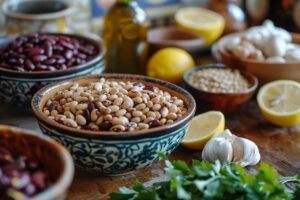
Beans are a big part of Mediterranean cuisine. Each country has its way of cooking beans. This creates a variety of flavours that show off local traditions.
Traditional Mediterranean Bean Dishes
Discover some famous Mediterranean bean dishes:
- Fava bean puree in Greece
- Spanish fabada bean stew
- Italian pasta e fagioli
- Moroccan chickpea tagines
European Heirloom Bean Varieties
European countries have their special bean varieties. These beans have unique tastes and textures. They are different from the beans you find in stores.
- Tuscan Cannellini beans
- French Tarbais beans
- Spanish Judión de la Granja beans
- Portuguese Feijão Manteiga
Cooking Methods for Mediterranean Beans
Learn how to cook Mediterranean beans the traditional way:
- Slow-soak dried beans overnight
- Use a clay pot or earthenware for authentic flavour
- Season with local herbs like rosemary and thyme
- Cook at low temperatures to preserve texture
Exploring Mediterranean bean varieties and cooking methods opens up a world of flavours and health benefits.
High-Protein Beans for Plant-Based Diets
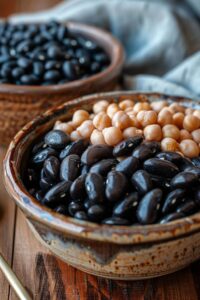
Plant-based diets are becoming more popular. High-protein beans are a great choice for those looking for protein alternatives. These beans are full of essential amino acids that help build muscle and keep you healthy.
Looking for the healthiest beans to eat? Here are some top picks for their high protein:
- Soybeans: Boasting approximately 28 grams of protein per cup
- Lentils: Delivering around 18 grams of protein per cup
- Black beans: Providing about 15 grams of protein per cup
- Kidney beans: Containing roughly 13 grams of protein per cup
Knowing how much protein is in beans helps you make better food choices. Here’s a detailed look at high-protein beans:
| Bean Variety | Protein (per cup) | Additional Nutrients |
| Soybeans | 28g | Omega-3 fatty acids, iron |
| Lentils | 18g | Folate, fibre |
| Black Beans | 15g | Antioxidants, magnesium |
| Kidney Beans | 13g | Vitamin K, potassium |
If you’re into vegetarian, vegan, or flexitarian diets, high-protein beans are a great choice. They’re tasty and good for you. Add them to salads, stews, or make bean burgers for a protein-rich meal.
“Beans are not just a side dish—they’re a powerful protein source that can transform your plant-based nutrition strategy.” – Nutrition Expert
Try different beans to get a variety of nutrients. Keep your diet exciting by experimenting with cooking methods and spices.
Best Beans for Soups and Stews
Starting with the right beans is key to making tasty soups and stews. These legumes add protein, depth, texture, and nutrition to your dishes.
Choosing the right bean is crucial for a great dish. The right bean can elevate your meal from good to amazing.
Thickness and Texture Considerations
Each bean type offers something special:
- Kidney beans: Make soups thick and hearty, perfect for chilli
- Navy beans: Give a creamy, smooth feel
- Great Northern beans: Add a lighter, more delicate texture
Cooking Times and Preparation Tips
Getting beans ready for soups and stews needs some planning. Dried beans cook longer, while canned beans save time. Here’s how to prepare:
- Soak dried beans overnight for quicker cooking
- Rinse canned beans to cut down sodium
- Add salt after cooking to avoid tough beans
Flavour Profiles and Combinations
Beans can mix with other ingredients to create amazing flavours. Try black beans with cumin and lime for a Latin twist. Or mix white beans with rosemary for a Mediterranean flavour.
“The secret to great soups is understanding how beans interact with other ingredients.”
Try different beans to find your favourite soup and stew recipes. Each bean adds its flavour, making cooking a fun adventure.
Fresh vs. Dried Beans: Storage and Preparation
Knowing the difference between fresh and dried beans can change how you cook. Each type needs its way to store and prepare to keep its quality and nutrients.
Fresh beans need careful handling and should be eaten quickly. Store them in a bag with holes in your fridge’s crisper drawer. They last 3-5 days before they lose their crispiness. When you’re making a salad, rinse them well and cut off the ends for the best taste and look.
- Fresh beans should be bright green and firm to the touch
- Check for blemishes or soft spots before storing
- Avoid washing until just before use to prevent moisture buildup
Dried beans can be stored for longer and are more versatile. Store them in airtight containers, away from sunlight and moisture. Dried beans can last up to 12 months without losing their nutritional value.
“The secret to perfect beans is patience and proper preparation.” – Chef Maria Rodriguez
To prepare dried beans, follow these steps:
- Rinse beans thoroughly to remove dust and debris
- Soak beans overnight in cold water
- Drain and rinse before cooking
- Simmer in fresh water until tender
Whether you’re making a colourful bean salad or a hearty stew, knowing how to store and prepare beans will improve your cooking. It will also make sure your dishes are delicious every time.
Conclusion
Your journey through different types of beans has opened a world of flavour and nutrition. Beans are packed with protein and offer a wide range of tastes and textures. They can make your meals healthier and more exciting.
Exploring various beans shows how versatile they are in cooking. They can be used in soups, plant-based meals, or even in Mediterranean dishes. Each type of bean adds its special touch to your food.
To dive deeper into legumes and their uses, check out these expert-curated resources:
These sources provide valuable insight into how different types of beans support heart health, blood sugar control, and digestive wellness.
Common Questions (FAQs)
Q: What are the healthiest beans to eat?
A: Black beans, kidney beans, soybeans, and chickpeas — all packed with fiber, protein, and nutrients.
Q: What’s the difference between beans and legumes?
A: Beans are a type of legume. Legumes also include lentils, peas, and peanuts.
Q: Can I freeze cooked beans?
A: Yes — they freeze well for up to 6 months in airtight containers.
Q: How do I reduce gas from beans?
A: Soak overnight, rinse canned beans, and use spices like cumin or fennel.
